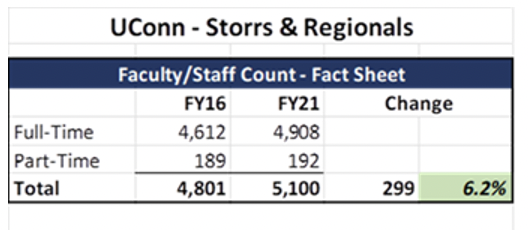UConn Response to Media Inquiry on Employee Compensation
UConn Response to Media Inquiry on Employee Compensation
Jan. 21, 2022
First, you said that the size of UConn's workforce had decreased since 2016. That is not the case, according to the numbers we have as shown in this chart:

It is accurate that UConn's faculty and staff payroll costs rose by 13% from 2016 to 2021. The key driver was collective bargaining increases negotiated by the state and SEBAC, which accounted for 11% of the 13% increase in UConn's salary costs during this time.
As to the list of employees you provided: With respect to coaches and leaders at UConn, including the president of the university and the CEO of UConn Health, pay is driven by national and regional markets and each individual's experience and skill set.
That is also true of many top physicians and researchers at UConn Health. Employers compete with one another to hire and retain the best in their fields. It is important to note that the UConn Health physicians on this list collectively generated $115 million in clinical care revenue for UConn Health from 2016 to 2021.
About 50% of UConn Health's revenues are from its clinical operation. State support accounts for 24% of its revenue, making the clinical care revenue generated by these and many other physicians at UConn Health all the more critical.
As Connecticut's only public academic medical center and largest producer of medical and dental professionals, UConn Health has an integrated tripartite mission of clinical care, education, and research.
It is important to note that the annual state support received by UConn Health actually funds the institution's education and research missions.
Also, this same state funding leads to the additional generation of more than $230 million annually in external funding to further support UConn Health's large education and research enterprises.
This includes more than $130 million from the Centers for Medicare & Medicaid Services (CMS) for advanced training of more than 725 new doctors across 68 graduate medical education training programs, and another $100 million plus in grants and awards.
In fact, overall state funding from 2016-2021 led to a minimum of an additional $1.1 billion in education and research funding for UConn Health.
Note that public service is an important part of UConn Health's mission as well. One in four of its patients are Medicaid recipients receiving care, including for specialty surgery and mental health. Also, UConn Health is the single largest provider of dental care to the uninsured and underinsured in the state. Plus, annually 18,000 state residents, many of whom are underserved and vulnerable, participate in free health care, screenings, and health-promotion education.
Clinical revenue at UConn Health has had unprecedented growth for more than a decade with steady annual increases in patient volumes (except in FY2020 due to COVID's impact). In fact, last year thanks to new strategic clinical initiatives such as the opening of its specialty pharmacy, clinical revenue increased by 23%.
Overall, clinical revenue has increased by 92.8% since 2010. Current 2022 budget projections are expecting clinical revenue to continue to grow by $53 million or 8%. This means since the start of Bioscience CT in 2010 to this current fiscal year, UConn Health's clinical revenue is expected to double.